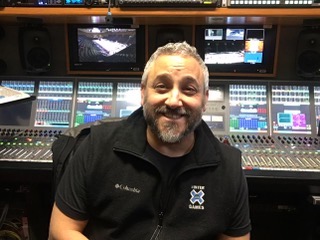Women’s College World Series Gets Big-League Audio Treatment
About 50 effects mics captured the event’s ‘pretty special sound’
Story Highlights
ESPN deployed a wealth of cool toys for this year’s NCAA Women’s College World Series (WCWS) — 80-ft. Rail Cam along the left-field and centerfield walls, two-point cable camera system down the third-base side, drone, Ump Cam — for the event’s return after last year’s COVID cancellation. On the audio side, the broadcaster made sure the broadcast sound was something special, too.
The action, which took place at the USA Softball Hall of Fame Stadium in Oklahoma City, was covered by an estimated 50 effects microphones throughout the infield and outfield. These included eight lavalier mics across the top of the outfield fences, which also had seven parabolic collectors attached to the inside of the logo-decked fence. Another three microphones covered the first- and third-base lines, and all three bases had their own wireless mics embedded inside. Bat cracks — and softballs making contact have their own distinct sound — are picked up by a pair of Sennheiser 8070 shotguns and a Sennheiser ECM77 behind the plate. And each umpire wore a lavalier and bodypack transmitter. (Coaches and managers were interviewed on the sidelines.)

A1 Daniel Bernstein notes that the whole production team was onsite for the NCAA Women’s College World Series.
But what sets women’s softball apart, just as college football has its marching bands, the WCWS has its dugout sound: teams chanting and singing as part of their psych strategies.
“That sound is very different from what you’d hear at a major-league baseball game,” says Daniel Bernstein, who alternated A1 duties on the day and night games with Steve Yoder, both working from Monday Night Football’s NEP EN1, sharing its Calrec Apollo console while submixer Joel Groeblinghoff worked the Calrec Artemis.
“With women’s softball, the main goal is capturing the energy in the dugouts,” Bernstein explains, noting that the dugouts themselves were wired for that purpose with a combination of lavs, short-shotgun, and PZM microphones. “It’s a pretty special sound.”
As was the sound of the crowds. The Softball Hall of Fame Stadium allowed a full house of 13,000 fans. To capture the excitement, Shure VP88 stereo mics were placed high and a pair of Sennheiser shotguns were placed at the announce booth and aimed to catch an up and down array of sound. A pair of large-diaphragm condenser mics atop the dugouts caught the call-and-response chants between teams and fans.
In another sign that sports production is returning to something like normal, the WCWS production was done entirely on location.
“Other than some statisticians working remotely,” says Bernstein, “everyone was onsite; there was no REMI component. All nine audio crew members were here. It was very refreshing, and it was something that [ESPN Senior Coordinating Producer] Meg Aronowitz wanted to make happen. It has been 730 days since the 2019 championship games, and we were ready to have it feel and sound like normal.”
